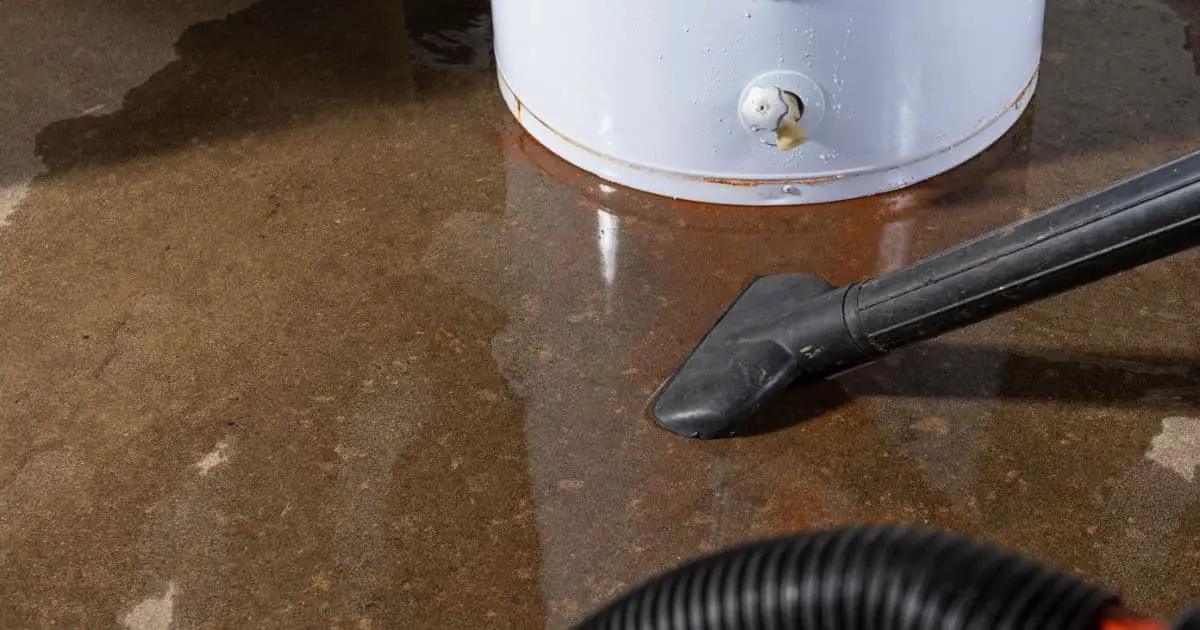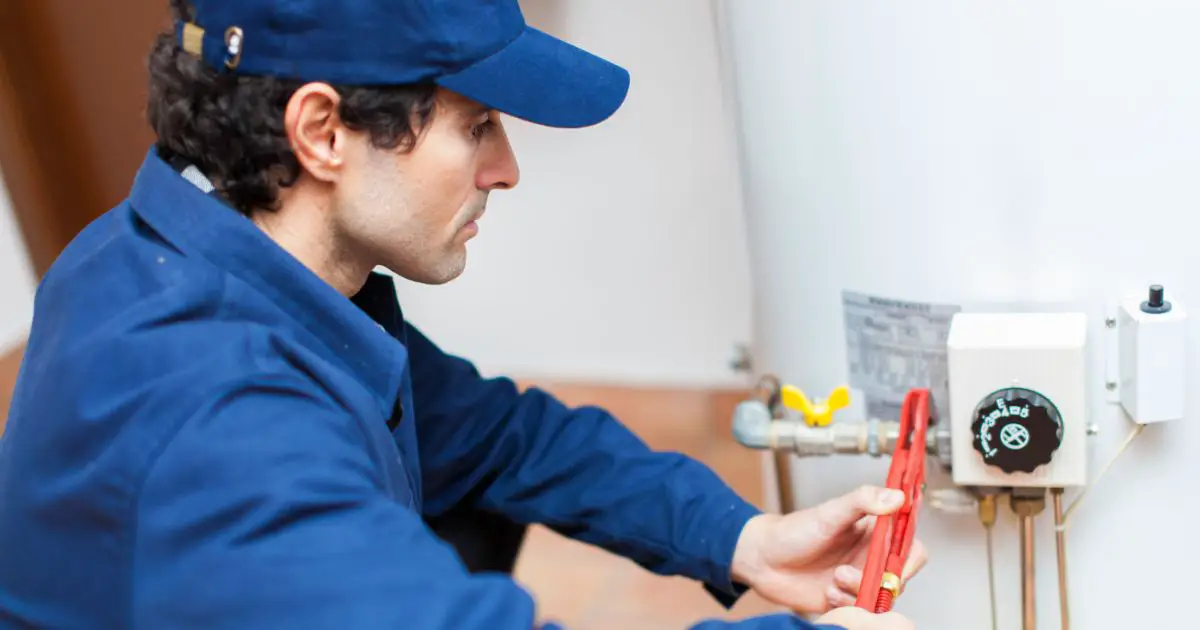The Best Guide for How to Identify and Fix Water Heater Leaks From the Top
Dealing with a water heater leak from the top can be extremely frustrating. The problem may be due to a loose connection during installation or simply a buildup of debris and excess sediments blocking the pressure relief valve.
Whatever the cause, a water heater leak can lead to potential over pressurization in your water heater which can then cause a water damage disaster.
One way to identify a water heater leak is if there is a pool of water gathering near your floor drain, or when the overall water supply is lower than normal. Strange sounds coming from the water heater tank are also a good sign there’s a problem.
If left unchecked, these issues could cause costly damages that require professional repair services and prompt action must be taken to prevent further problems from occurring.
Reasons Why Your Water Heater is Leaking from the Top

Water heater leaks from the top are generally caused by:
Drain Valve Issues
A drain valve issue can be caused by a faulty gate valve or a slow drain valve leak. Over time, this can lead to an increased airborne water level which may cause debris and sediment build up in the pressure relief valve.
This will prevent your pressure relief valve from performing its function of releasing excess water pressure, thus leading to an eventual water heater leak from the top.
Tank Corrosion
Tank corrosion is often the result of metal tanks that are not regularly maintained. Rust and corrosion can occur over time, leading to the breakdown of the tank, and eventually causing sediment buildup within the water heater. This may lead to a water tank leak from the top if it’s not repaired quickly.
Loose Connections
Loose connections between pipes and fittings are a common cause of water heater leaks from the top. A plumber may have overlooked or incorrectly installed the joining parts of the water heater, resulting in an incomplete seal and loose joint that allows water to escape.
If you encounter this problem, it’s recommended to immediately hire a different plumber who can assess the situation and repair loose connections before the leak becomes worse.
Leaky Pipes
Leaky pipes are typically found in older water heater systems, and can also be caused by incorrect plumbing installations. This happens when the seal between the pipe and the water heater is not tight enough to prevent any water leakage.
Faulty Anode Rod Connections
Faulty anode rod connections can lead to a water heater leak from the top, as it may cause corrosion which leads to weakened material in the tank over time.
Outlet Fittings
Outlet fittings can fail after years of use and can let out water when under pressure from the heater.
Old Tank
The metal used in an old water heater tank deteriorates over time and becomes more susceptible to rust and corrosion, leading to a water heater leak from the top.
Possible Solutions to Water heater Leaks From the Top
Leaking water heaters can cause big issues for any homeowner. To ensure your property stays dry and damage-free, it’s important to fix a water heater leak from the top before it becomes too severe. There are a few practical approaches you can try, such as:
Drain Valve Fixing
- Shut off the electrical power or gas supply for safety reasons, and make sure you wear long sleeves, safety glasses, work gloves, and sturdy shoes.
- Use pliers to remove the bolts which secure the drain valve before using a bucket to catch any remaining water from the tank.
- You can buy seal replacement kits at hardware stores or online retailers if needed; however, you may find that due to regular wear and tear simply re-tightening the valve may do the trick.
- Once all parts are connected properly and tightened as recommended in user guides (which come with most heaters), make sure each part is secure before finally turning on either a gas or electric supply.
- After proper setup, turn on the hot water taps to check for leaks before switching them off once again.
The solution to Tank Corrosion
If your water heater is leaking from the top due to corrosion, these are a few things you can do at home to minimize this problem:
- Check for cracks or holes in the outer tank, and if any are found you’ll need to replace the entire water heater.
- If there are no cracks, try cleaning off the sediment buildup on the outside of the tank with a scrubber.
- Remove mineral buildup inside the tank to prevent further corrosion and extend its lifespan by using vinegar or baking soda along with boiling water and pouring it in through a funnel onto the long metal rod inside the top of your water tank.
- Replace your current anode rod with one made of stainless steel alloy which offers much more protection against corrosion.
Tightening Connections
- Turn off the power or gas that feeds into your water heater. This will ensure that no electricity or gas has flared up when you go to make adjustments to the system.
- If there are any visibly loose connections in your pipes you should tighten them using a wrench until they are snug.
- Inspect all components of your water heater and ensure there aren’t any other connections that seem loose.
If you identify an issue that may require further assistance, we recommend contacting a professional for expert help and advice. Fixing this problem is an easy solution to avoid more expensive repairs down the line!
Pipe Insulation
Use pipe insulation to insulate the temperature-pressure relief valve, this will help to stop or lessen temperature swings and can aid in the removal of calcium carbonate accumulation over time. This can be done following these simple steps:
- Ensure that the water heater tank and pipes are completely dry, as this will help prevent problems like rust or mold in the future.
- Use heat tapes, which can resist heat and cold simultaneously, helping to preserve both efficiency and safety.
- Wrap your pipes in foam rubber tubing or fiberglass.
In areas prone to extremely cold temperatures, thicker insulation should be used to protect against freezing conditions and other damages caused by the climate. All of these simple steps can help prevent costly repairs and provide worry-free operation for years to come.
Reset Your Thermostat
Adjust your water heater thermostat to a recommended setting of 120 degrees to reduce temperature swings in the tank and further guard against leaks caused by calcium carbonate accumulation.
Pipe Fixing and Resealing
Once you’ve checked all the pipes, tightening or replacing any that may be defective, you should inspect the cover and anode rod. If either of these is faulty and needs replacing then it’s important to do so as soon as possible as they essentially act as shields against corrosion.
Reseal the pipes near your water heater thermostat withcaulking tape. This will stop the water from leaking out of any gaps or cracks.
Note: Though it may not always be necessary to replace parts if everything is as it should be you can rest assured knowing that your water heater is back in proper condition!
Replacement
If none of these solutions work, it may be time for a replacement. You can opt for a new tankless water heater, which doesn’t need a storage tank and is more energy efficient. Alternatively, if you require hot water in bigger capacities, you can invest in a hybrid heat pump water heater that uses less electricity than traditional water heaters.
No matter your choice of solution, it’s important to seek professional advice from residential plumbers when dealing with a water heater leak from the top. They will be able to assess the situation and advise you on the best measures that can be taken to stop any further leakage and prevent costly damages.
By following these steps and solutions, you should be able to effectively address your water heater leak from the top as quickly as possible. With regular maintenance and preventive measures, you can ensure your water heater will be safe and leak-free for many years to come.
Tips for Fixing a Water Heater Leak from the Top

If your water heater tank is leaking from the top, here are a few tips for fixing it:
- Immediately turn off the power source to your water heater and close all valves to stop any further leakage.
- Call a professional plumber or repair technician to inspect and assess the damage, as well as replace any faulty parts.
- If you suspect any pipe or valve leaks, ensure to replace them immediately.
- You can make use of tankless water heaters that do not store water in tanks.
- If the tank has become corroded over time, it may be necessary to replace the entire unit to avoid further damage.
- Check that all connections are properly sealed and tight before turning on the electricity again.
- Install a pressure relief valve onto your water heater system to reduce the chances of over pressurization.
- Perform regular maintenance and inspections on your water heater to prevent any future leaks from occurring.
Final Thoughts
Water heaters are essential for hot showers and providing families with quality hot water during the colder months. It’s necessary to address any water heater leaks from the top as soon as possible to avoid any potential catastrophes.
If done properly, checking for a water heater leak from the top requires basic plumbing knowledge, or calling an experienced plumber to inspect your entire plumbing setup as soon as you spot the earliest sign.
A professional plumber will be able to assess whether your hot water tank needs a small part replacement or only needs to be cleaned regularly to clear debris and increase pressure relief valve functioning.
To prevent this issue from recurring, you can make use of tankless water heaters that do not store water in tanks. Do not wait until it’s too late!
With years of experience under his belt, Adam decided to put his water heater knowledge to work. By providing high-quality content and expert guides, Adam hopes to help anyone looking for expert water heater advice.